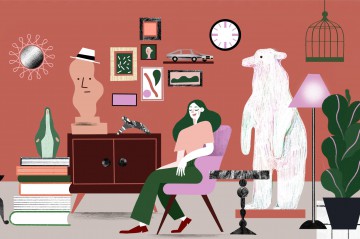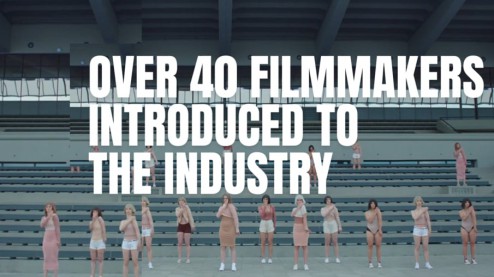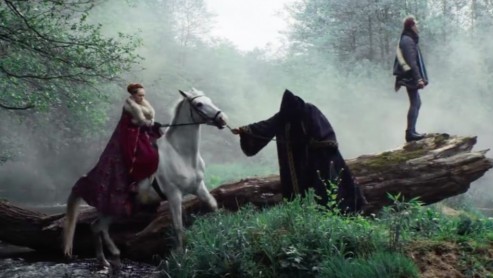Sylwia Chutnik | The Ćmielów Ladies12.12.2018
Porcelain figurines warm my heart. One look at their picture and I’m already better. Only for a moment, but decidedly better.
Trinkets, often called bric-a-brac, essentially exist to exist, they serve no useful function, except for maybe filling up space, gathering dust, or smashing against the ground when touched by a cat. Given the rather small spaces I had to live in over the years, I learned how to surround myself only with useful artifacts. That does not mean to say that I don’t own useless and pointless stuff. I already wrote about my hopeless messiness and I have made my peace with it. But we will not be discussing the plastic Virgin Mary-shaped holy water receptacle collection or the miniature world of moss and fern, inhabited by a little Bambi analog and an angel diminutively called Sylwunia, not this time, my dears. Today, we’ll talk a little about objects that are both beautiful and moving but definitely beyond my reach in economic terms.
Marcin Wicha stopped loving design for a lot of reasons, one being the absurdly high prices of everyday objects. His sentiments were echoes by Filip Springer. A masterpiece of art is one thing, but a toilet brush for a grand is something else.
During prep work for this essay, I came across an obit for Lubomir Tomaszewski, the designer responsible for the shape of most of my favorite figurines. Although he lived to the ripe old age of 90, only ten of those years were dedicated to design work. And to what marvelous effect! In the late 1950s, a small office was attached to the Institute of Industrial Design—the Experimental Production Office manufactured small batches, sometimes even single pieces, of figurines, vases, and ashtrays and sent them to select stores across the country. Although steeply priced, these were highly prized possessions and were bought up nearly immediately after appearing in stock. Tomaszewski designed thirty models of small-scale sculptures and every single one is absolutely breathtaking.
The airy, delicate form highlights the figurine’s porcelain character better than any detail on kitschy ballerinas that crowd the shelves at every flower shop you’ve ever been to.
Let’s take the “Girl in Trousers” for example, the epitome of the emancipatory style. With her hair done up and bell bottom pants with black horizontal stripes. The slender, svelte shape of the figurine is emphasized by its custom stand, created from the hems of the pant legs. This, in turn, build the distinct impression of the figurine floating above the ground. The airy, delicate form highlights the figurine’s porcelain character better than any detail on kitschy ballerinas that crowd the shelves at every flower shop you’ve ever been to.
And the “Sexbomb” series? Pig-tailed girls bearing some resemblance to Alina Szapocznikow’s “Difficult Age” on the one hand, and to Kalina Jędrusik and the later looks of Violetta Villas on the other. You know, that effortless sex appeal. True, their busts are highlighted but their stance, their self-presentation, is a clear sign of self-assuredness. Curiously, they’re all striking the universally loathed “duck face” pose. Any minute now they’re going to pull out a phone to take a selfie.
But out of all of Tomaszewski’s creations, the “Singers” are the the most famous and celebrated. They depict women standing with heads slightly tilted back, mouths open. Short hairstyles, with a single lock of hair slicked back by the ear. They’re wearing long, mostly unicolored dresses—you can pick one in red, in black, or even a blue one with flecks. A couple of years back, large replicas of the figurines were crafted out of wood and placed on the main square in Kielce. The design worked just as well in larger sizes.
The two coffee serving sets are another story. Many people were delighted with the form, the slender shape, the colors, and the decision to dispense with handles. And let me tell you that I live my life on the edge and drink tea from an old, chipped cup. But if I had gems like these at home, I’d celebrate the very act of drinking coffee. Because beautiful objects demand our attention. Require us to stop if only for a moment. True, they’re charming and demanding, because they need a lot of our attention. But the power residing in their rich details—colors, signatures at the bottom, or shapes, prevents us from treating them superficially, from simply chucking them into the dishwasher or spraying them with household products. Oh, no. We coddle these figurines, little plates and pots, allowing ourselves a brief moment of porcelain affection.
What will be left of us? Maybe IKEA catalogs. But can anyone really live inside one, aside from the plush snake that spills its cotton wool filling a couple of days after purchase?
When it comes to figurines, you can write a poem about them or use them in a story. If I were to do it, I’d have all the Tomaszewski-designed figurines know each other, live in the same apartment building, and enjoy scores of adventures and affairs. The coffee pot and cups would be their cars, vehicles in which to travel far and wide. They could also drop by the National Museum in Warsaw, which has had a separate room dedicated to showcasing industrial design for some time now. A couple of years back, the room was host to “We Want to Be Modern,” an exhibition that affected me so profoundly that I couldn’t sleep later that night. Everything there fit together so well, the singers and the bell-bottom pants-wearing girls could easily live there, putting their legs up on Sztaba-designed chairs or amidst iconic furniture sets that paired so well with government-furnished two-bedroom apartments.
What will be left of us? Maybe IKEA catalogs. But can anyone really live inside one, aside from the plush snake that spills its cotton wool filling a couple of days after purchase?
Sometimes, I imagine myself being locked inside the Ćmielów plant for the night, the same place that manufactured the majority of these porcelain gems. I see myself strolling through the factory grounds, touching the wares, the coffee services sets, the saucers. I am Alice in Wonderland, sitting for tea with the queen. But the wonder is accompanied by fear, fear of breaking everything into smithereens, a disaster that would undoubtedly leave me crying on the floor.
But the figurines, at the very least the Tomaszewski-designed ones, are eternal. They are exempt from the laws of gravity, immune to hard floors. They exist beyond physics, beyond time itself.
see also
- Sylwia Chutnik | Sc**w minimalism

Opinions
Sylwia Chutnik | Sc**w minimalism
- Sylwia Chutnik |
A Collection of Delightful Events

Opinions
Sylwia Chutnik | A Collection of Delightful Events
- IMDb Joins Forces with Amazon to Release New Streaming Platform

News
IMDb Joins Forces with Amazon to Release New Streaming Platform
- A World Straight Out of Hitchcock. See the Animated Film Exploring the Boredom of Quarantine
News
A World Straight Out of Hitchcock. See the Animated Film Exploring the Boredom of Quarantine
discover playlists
-
Papaya Young Directors 5 Awarded films
 09
09Papaya Young Directors 5 Awarded films
-
Papaya Young Directors top 15
 15
15Papaya Young Directors top 15
-
Papaya Films Presents Stories
 03
03Papaya Films Presents Stories
-
Instagram Stories PYD 2020
 02
02Instagram Stories PYD 2020
